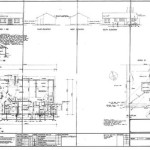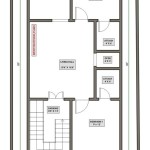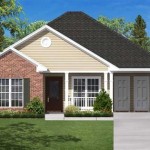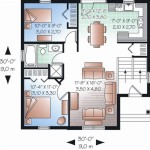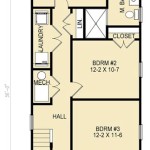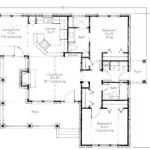Walk-Out Basement Home Plans: Expanding Living Space and Value
Walk-out basement home plans represent a popular choice for homeowners seeking to maximize their living space and enhance their property value. These designs take advantage of sloping lots, allowing for the creation of basements that function as fully integrated extensions of the main living area. Unlike traditional subterranean basements, walk-out basements feature at least one wall with direct access to the outdoors, typically through a door or sliding glass door, and often include windows that let in natural light. This feature significantly transforms the usability and desirability of the basement space, making it a versatile and valuable asset to any home.
The appeal of walk-out basement home plans stems from their ability to provide additional living area without the expense of constructing a completely new addition. This is particularly beneficial in areas where land is scarce or zoning regulations restrict building outwards. Furthermore, the enhanced natural light and accessibility of a walk-out basement contribute to a more comfortable and inviting living environment, differentiating it from the often-damp and dimly lit characteristics of traditional basements. The design possibilities are extensive, allowing homeowners to tailor the space to their specific needs and preferences.
Key Benefits of Walk-Out Basement Home Plans
The adoption of walk-out basement home plans offers a multitude of advantages that extend beyond simply increasing square footage. These benefits impact the overall functionality, value, and desirability of a property.
One primary benefit is the increased living space it provides. A finished walk-out basement can effectively double the usable area of a home, offering room for additional bedrooms, bathrooms, recreational areas, home offices, or even a separate apartment. This expansion is particularly attractive for growing families or those who frequently entertain guests. The flexibility of the space allows homeowners to adapt it to changing needs over time, maximizing the long-term value of the investment.
Another significant advantage lies in the enhanced natural light and ventilation. Traditional basements are often characterized by a lack of natural light and poor air circulation, leading to a damp and sometimes musty environment. Walk-out basements, with their exterior access and windows, mitigate these issues. The influx of natural light brightens the space, making it more appealing and comfortable. Improved ventilation helps to reduce moisture levels, preventing mold growth and contributing to a healthier living environment. This makes the space more conducive to a wider range of uses, from bedrooms and family rooms to home gyms and workshops.
Finally, walk-out basements significantly enhance property value. The added living space, combined with the improved aesthetics and functionality, makes the home more attractive to potential buyers. Appraisers often consider finished walk-out basements as valuable assets, contributing to a higher overall property valuation. Furthermore, the presence of a separate entrance can create opportunities for rental income, particularly if the basement is designed as a self-contained apartment. This can provide a significant return on investment and make the property more financially attractive.
Design Considerations for Walk-Out Basement Home Plans
Successfully implementing a walk-out basement home plan requires careful consideration of several design factors. These factors include site conditions, drainage, egress requirements, and interior layout.
Site conditions play a crucial role in determining the feasibility and cost-effectiveness of a walk-out basement. The slope of the land is the most important factor. A sufficiently sloped lot is necessary to expose one or more basement walls fully at grade level. The soil type and stability also need to be assessed to ensure the integrity of the foundation and prevent potential issues such as landslides or soil erosion. Furthermore, the presence of bedrock or underground utilities can significantly impact construction costs and require specialized engineering solutions.
Proper drainage is essential to prevent water damage and maintain the integrity of the foundation. Walk-out basements, by their nature, are more susceptible to water infiltration than traditional basements. Therefore, a comprehensive drainage system is crucial. This system should include measures such as grading the land away from the foundation, installing perimeter drains, and using waterproof membranes on the exterior walls. Furthermore, proper guttering and downspouts are necessary to divert rainwater away from the foundation. Regular maintenance of the drainage system is also crucial to ensure its continued effectiveness.
Egress requirements are critical for ensuring the safety of occupants in the event of a fire or other emergency. Building codes typically require that walk-out basements include at least one means of egress, such as a door or window that can be easily opened from the inside without the use of tools or keys. Egress windows must meet specific size and placement requirements to allow for safe and easy escape. Adhering to these requirements is essential for obtaining building permits and ensuring the safety of the home's occupants.
The interior layout of the walk-out basement should be carefully planned to maximize its functionality and appeal. Considerations should include the placement of windows and doors to optimize natural light and ventilation, the arrangement of rooms to create a comfortable and functional living space, and the location of utilities to minimize noise and disruption. Furthermore, the interior finishes should be carefully selected to create a cohesive and inviting atmosphere. Choosing durable and moisture-resistant materials is particularly important in basement environments.
Maximizing the Potential of a Walk-Out Basement
Once the design and construction phases are complete, several strategies can be employed to maximize the potential of a walk-out basement and transform it into a valuable and enjoyable living space. These strategies include optimizing natural light, creating a seamless transition to the outdoors, and incorporating functional design elements.
Optimizing natural light is essential for creating a bright and inviting basement environment. Strategies include maximizing the size and number of windows, using light-colored paint and finishes to reflect light, and incorporating strategically placed mirrors to bounce light around the space. Furthermore, landscaping can be used to enhance natural light by pruning trees and shrubs that may be blocking sunlight. Light-colored window treatments can also help to maximize the amount of natural light that enters the space.
Creating a seamless transition to the outdoors enhances the enjoyment and usability of a walk-out basement. This can be achieved by incorporating features such as patios, decks, and outdoor living areas that are directly accessible from the basement. These outdoor spaces can be designed to complement the interior living space, creating a cohesive and functional extension of the home. Furthermore, landscaping can be used to soften the transition between the interior and exterior, creating a more natural and inviting environment.
Incorporating functional design elements can significantly enhance the usability and appeal of a walk-out basement. This includes features such as built-in storage to maximize space, flexible furniture arrangements to accommodate different activities, and designated areas for specific purposes, such as a home office, a recreation room, or a guest suite. Thoughtful planning and attention to detail can transform a walk-out basement from a mere storage area into a valuable and versatile living space. The addition of a wet bar or kitchenette can further enhance the functionality of the space, making it ideal for entertaining or accommodating guests.
Ultimately, walk-out basement home plans offer a unique opportunity to significantly enhance the value and usability of a property. By carefully considering the design factors and implementing strategies to maximize the potential of the space, homeowners can create a valuable and enjoyable living environment that adds lasting value to their home.

Modern Farmhouse Plan W Walkout Basement Drummond House Plans

Walkout Basement Contemporary Style House Plan 8588

Walkout Basement House Plans To Maximize A Sloping Lot Houseplans Blog Com

Exclusive Ranch Home Plan With Walk Out Basement Option

House Plan 3 Bedrooms 2 5 Bathrooms 3992 V3 Drummond Plans

Walk Out Basement Home Plans Search Floorplan Blueprints

Walkout Basement House Plans Floor For Builders

Walkout Basement Craftsman Style House Plan 8752

Small Cottage Plan With Walkout Basement Floor

Walkout Basement House Plans With Photos From Don Gardner Houseplans Blog Com


